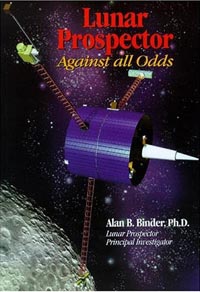Review: Lunar Prospector: Against All Oddsby Anthony Young
|
| In terms of its sheer size, length, and devotion to detail, one could say it is the non-fiction and scientific equal of J. R. R. Tolkien’s Lord of the Rings. |
After the prologue, which briefly covers lunar observation and exploration between 1865 and 1988, the book is divided into four parts. Part one, “The Early Years”, recalls the period from November 1988 through February 1995 that involved spacecraft design studies and political machinations. Part two, “Success at Last”, deals with the months from the end of February 1995 through September 7, 1995 when Lunar Prospector was selected as a Discovery mission. Part three, “Building Lunar Prospector”, covers design of the spacecraft, its instrument packages, testing, and preparation of the spacecraft for launch during the period from September 8, 1995 through January 5, 1998. Part four, “The Lunar Prospector Mission”, describes the period between January 6, 1998 (the day of its launch) and the satellite’s mission through July 31, 1999, when it performed its programmed impact on the Moon. There is an epilogue covering the mission’s aftermath and scientific payoff, and extensive appendices. There are 53 pages of black and white photos that cover this entire period. Binder writes in the first person, and many passages cover day-to-day events in the Lunar Prospector saga. Over the years of the program he chose to record every day’s events on audio tape instead of writing them down longhand so he could recall events for himself and for posterity.
In terms of its sheer size, length, and devotion to detail, one could say it is the non-fiction and scientific equal of J. R. R. Tolkien’s Lord of the Rings. Dr. Binder’s magnum opus is nearly 1,200 pages in length and over six centimeters thick: why would you want to read such a massive book? Over the last 50 years, there have been no books written by the principal investigators of spacecraft sent to the Moon or the planets with such an insider’s critical view of events. In the case of Lunar Prospector, Binder was not only the PI who assembled the scientific team, he was the spacecraft systems engineer, marshaled the support of numerous aerospace corporations that would build the spacecraft and launch vehicle, battled the NASA juggernaut to get Lunar Prospector approved as part of the Discovery program, and was mission director. He fought off numerous attempts by various parties to kill the project outright or let it die from neglect. At the same time, he gives proper credit to those who contributed and faithfully worked with him on the Lunar Prospector program and mission.
Dr. Binder had the unflagging help of many scientists, engineers, and true believers in the noble idea of Lunar Prospector—to build and launch a lunar spacecraft for a fraction of the cost of a typical NASA planetary probe program. Lunar Prospector achieved its mission objectives and did so at a cost of $65 million, including the cost of the Lockheed Martin Athena 2 launch vehicle and complete mission support. Today, NASA states a Discovery mission must cost no more than $425 million. Lunar Prospector was indeed proof spacecraft missions could be conducted much cheaper and better than other big-ticket missions of the past, or the costly failures that came later. This book is an engrossing chronicle of what goes on behind the scenes and what must happen before a spacecraft is sent on its way into space.
